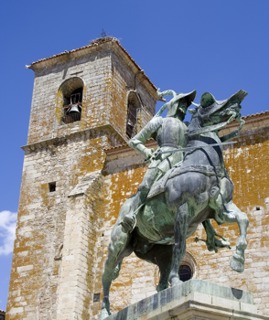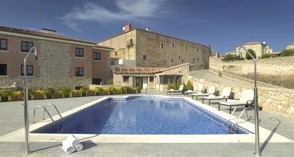
TRUJILLO, Estremadura, SpainThere are two parts to Trujillo; the ‘city’ refers to the districts which expanded during the 15th and 16th century, whereas the medieval ‘village’ was around the time of Arab rule. A wall with no less than 17 towers surround the village, and inside are the ruins of the Citadel of the Bejarano and the Jeronimas lookout. In 1232 King Fernando III conquered it from the Arabs, and it was a whole century later, during the reign of Juan II, that it was given the title of city. During the 16th century it fell within the Route of the Conquistadors, and became linked to many important figures connected with the discovery of America. As a consequence it experienced an age of great splendour. The Coria Museum inside the San Francisco el Real Convent is dedicated to the important milestones in the discovery of the New World.  The 13th century Trujillo Castle dominates the city as it stands on the highest part of town. It was built on the site of an old 10th century Arab fortress, preserving the square towers which were typical of the Moors military architecture. Over the centuries the city was built around the grand Plaza Mayor Square where you will find a bronze statue of Pizarro mounted on a horse. This has always been the heart of where everything happened such as social events, weekly markets and annual festivals. This is also where many of the Conquistadors and other noble families built their homes.
The 13th century Trujillo Castle dominates the city as it stands on the highest part of town. It was built on the site of an old 10th century Arab fortress, preserving the square towers which were typical of the Moors military architecture. Over the centuries the city was built around the grand Plaza Mayor Square where you will find a bronze statue of Pizarro mounted on a horse. This has always been the heart of where everything happened such as social events, weekly markets and annual festivals. This is also where many of the Conquistadors and other noble families built their homes.
Many of the palaces and manor houses have angular balconies, which was a very distinctive style of Trujillo architecture between the 16th and 18th century. The most spectacular example of this is the Palace of the Marquises of the Conquista, commissioned by Pizarro in 1570, with its magnificent Coat of Arms and corner balcony. Other wonderful sites to visit are the Citadel of the Altamiranos built in the 13th century with two towers that flank its main gate, and the Romanesque Santa Maria Temple. The temple was constructed on the site of an old mosque and has many medieval portals on the outside. Inside is an outstanding Gothic altarpiece made by Fernando Gallego in 1480. Also dating back to the 13th century is the Santiago Church, next to the Santiago Gate, which was later re-modelled with only the semi-cylindrical apse and tower left of the original construction. Beyond Trujillo is the Monfrague National Park which has the largest and best preserved Mediterranean forest worldwide. The park covers 18 hectares of hills, rocks and streams, and is filled with walking routes and activities for visitors to enjoy. The Monfrague National park has the largest colony of black vultures and Imperial Eagles in the world, and is also one of the few habitats where animals such as the Iberian Lynx have survived. For those fascinated by cave paintings, there is also the Castillo Cave which is open to the public. Or just north of Trujillo is the Jerte Valley which is particularly stunning in the spring when all the cherry trees are in blossom. With regard to accommodation in Trujillo, there is no place finer than the Parador Hotel Trujillo. Once the 16th century Santa Clara Monastery, it was been converted into a luxury four star hotel with two beautiful cloisters, a lovely garden, seasonal swimming pool and a restaurant serving traditional recipes. There is truly no nicer place to stay if you are looking for an ambience of peace and tranquillity. During Easter the town hosts the Chiviri Festival which is particularly popular with the tourists, and in June is the La Revoltosa Ball during the Santa Ana Festival. So if you are considering visiting Trujillo, spring or early summer is the best time to go. |